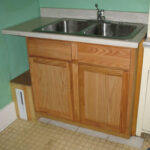Plumbing is a something that is good to know a little about, but you should call your landlord or a professional plumber if there are any big problems.
We’ll cover just a few basics: fixing a stopped-up toilet, fixing a toilet that won’t flush (or stop flushing), getting a slow-draining sink or shower to work, retrieving a ring or other valuable item dropped down a sink, and changing a shower head. All of these are things you can do yourself.
The most immediate of all plumbing problems happens when you flush and the poo doesn’t. Your toilet backs up, and instead of going down, the water (and the rest) rises up. Fortunately, even if the toilet is completely blocked, one flush usually won’t overflow and spill out onto your floor. What you’ll need to do is let the water stop rising and get out your trusty plunger. Don’t have a plunger? Put it on your shopping list and buy one the next time you’re out. They are one of those things you don’t need often, but when you do nothing else will work.
Believe it or not, there are different kinds of plungers, and some work better than others. The good ones have a kind of bulb-shaped business end that fits into the bottom of a toilet bowl. These work better than the standard old-school dome-shaped ones, but are a bit more expensive. Whatever kind you get, they’re all pretty easy to use.
1 . Put your plunger into the toilet and position it over the hole where the water is supposed to drain out.
2 . Now, slowly at first, push – plunge – it down. The idea is that you’re pushing water against the blockage, and that the water pressure will force it free. It’s the same principle that makes the brakes work in your car, by the way. Go slowly at first because you’ll have air trapped in your plunger during that first push, and you don’t want to make big splashing bubbles.
3 . Once the air is out, plunge away, down and up as many times as it takes to clear away the blockage. You’re trying for a tight seal and well-directed pressure here, not speed. You’ll know you’ve cleared it when the toilet drains. Until the toilet drains, be real careful about flushing again so you don’t cause an overflow.
4 . If after much plunging the toilet is still stopped up, call your landlord and have him or her them send a plumber. If you don’t rent, call a plumber yourself.
There are two other flushing-related problems you may encounter: Pushing the flush handle and nothing happens, or pushing the handle and having the toilet flush but not stop flushing. These are both easy problems to fix.
If you push the handle and nothing at all happens, what’s probably happened is that the chain that connects the handle to the flapper inside your toilet tank has come off. The piece really is called a flapper, too. To fix it, you’ll have to take the top off the toilet tank and reattach the chain.
The tank is that square boxy part above the toilet bowl, and the lid just lifts off. Remove the lid and set it aside. Take a look inside. Starting at the top, find the flush handle. What you see from the outside of the toilet is just half of it. The whole handle is like a see-saw – when you press down on the outside half, the inside half goes up. It’s connected to the flapper at the very bottom of the toilet tank by a metal or plastic chain, and when the handle goes up, it lifts the flapper. When the flapper goes up, the weight of the water in the tank forces the water in the toilet bowl down, flushing it. When the tank is empty, the flapper falls back down and the tank refills. It’s a really simple and effective system.
So if you press the handle and the toilet doesn’t flush, chances are the chain has come off or broken. Usually you’ll see it sitting down at the bottom of the tank. To fix it, all you have to do is reach in, lift the chain up, and reconnect it to the inner arm of the handle. If the chain is broken, which sometimes happens when they’re old and rusty, you can usually use a paper clip to connect the two ends and it’ll work fine.
But isn’t the water in the tank all toilety and gross? Actually, it’s not. The water in the tank has come straight from your pipes. It’s never been in the toilet bowl (and won’t ever be if you don’t get the chain fixed)! Toilet tanks can be rusty or a little slimy, but there’s no poo or pee in them to worry about, so you can reach in and fix what needs fixing without shoulder-length rubber gloves. It is always a good idea to wash your hands afterward, though.
Once the chain is reconnected to the flapper and handle, test it. Flush and watch what happens inside the tank. The flapper should go up and stay up while the water drains out of the tank, then fall down and seal completely. If the chain is too long, the flapper may not rise up enough to stay up by itself and let the water flow out. If that’s the case, adjust your paper clip or the connection to the handle to shorten the chain.
If your toilet runs all the time, it’s because the flapper isn’t sealing completely. If that’s the case, check to see if the chain is too short or got caught on something and is being held open. Adjust it so the flapper can close completely. If the chain has slack in it and the flapper still doesn’t seal, make sure there isn’t an extra length of chain or anything else beneath the flapper holding it open. If there’s nothing blocking the flapper that you can see but your toilet still runs all the time, call your landlord. A running toilet wastes hundreds of gallons of water a day.
One time when my wife was visiting her sister down in Santa Barbara she took a shower and found herself standing in ankle-deep soapy water the whole time. Afterward, she asked Gina how long it’d been like that.
“About a month,” Gina answered.
“Have you tried Drano?” my wife asked.
“What’s Drano?” my 3.85-GPA-science-student sister-in-law replied. (She could be your child’s pediatrician someday, so don’t laugh.)
Drano is a product that dissolves away clogs in sink and shower drains. It’s a very caustic chemical – you don’t want to get any on you or your clothes – but it works great for clearing clogged and slow-running sinks if you can’t clear the blockage yourself. Liquid Plumber is another good brand. There are others as well.
The first thing to do is see if you can pull up all the hair and goop that’s stopping up your sink and shower with your fingers or needle-nosed pliers. Often times, this is all it takes.
If not, and you want to take chemical action, get some drain opener at the local store.
The thick, gel-like liquids work the best, and all you have to do is pour the recommended amount into your sink or shower, let it sit for 15 minutes or so, then run lots of hot water down the drain. If it doesn’t work the first time, try a second time. It’ll usually do the trick. If it still doesn’t work, call the plumber.
Here’s an unhappy moment: You’re getting undressed after a night on the town and drop a diamond earring into your sink. Or a cufflink. (Does anybody still wear cufflinks?) You grab for it, but before you can reach it that quarter-carat disappears down the drain.
It happens. Fortunately, you can get your earring back 99 percent of the time, as long as you do not run the water. And believe it or not, you have sewer gases to thank.
Take a look under your sink. You’ll see a pipe coming down straight from the drain. It attaches to a J-shaped piece of pipe that attaches to more pipes that disappear into the wall.
It’s that J-shaped piece of pipe that’s important here. It’s called a trap, and even though it’s there to keep sewer gases out of your bathroom, it’ll also let you retrieve a lost doodad. You may need a few tools for this, but it’s doable. And in case you care how it keeps sewer gases out, it’s like this: The J of the trap stays filled with a little bit of water all the time, and that water acts as a plug keeping the stinky gasses in the sewer lines where they belong. Sometimes in a house that’s been sitting empty a long time, you’ll smell a sewery smell from the sinks because the water in the traps evaporated away. Just run a little water down the sink, and it’ll be fine again.
Opening A Sink Trap:
Here’s What You’ll Need: Bucket or Pan (To Catch Trapped Water), A Pair of Large Channel-Lock Pliers or a Pipe Wrench, And Teflon Tape.
1 . Now don’t freak out. Channel-lock pliers are just big adjustable pliers that can grab skinny stuff or wide stuff. Drain pipes are fairly wide, so you need a pair of channel-locks big enough to get a good grip on your pipes. The jaws of the pliers should be on opposite sides of the pipe. If they’re not, the pliers aren’t big enough. Pipe wrenches are just big adjustable wrenches made for plumbing work. You can get either at a local hardware store. Teflon tape sounds all high-tech, but it’s just a thin strip of white plasticy Teflon sold in a roll that looks like first-aid tape. It’s not even sticky, and it’s less than a buck at any hardware store. And if the pipes are plastic, you probably won’t need any of it.
2 . Okay, here’s what you’re gonna do. Put the bucket under the sink trap and get down there yourself so you can see. At either end of the trap, you’re going to find a nut that holds the trap in place. What you need to do is loosen both of those nuts. If the pipes are plastic, you’ll probably be able to do it with your hands. If they’re metal, you’ll likely need to use the wrench or pliers. Get a good tight grip on the nut and turn it counter-clockwise. (Lefty-loosy, righty-tighty.) Loosen both all the way, and the trap will pull straight down. The nuts don’t come off in your hands – they stay attached to the bits of pipe under the sink. You may need to wiggle the trap a little to get it free. When it comes off, water – and your diamond earring – will pour out into the bucket. Yeah!
If there’s also a lot of gunk in there, now’s a good time to clean it out. Once it’s clean, you’ll need to reattach the trap.
3 . Start by pushing it back in place. Twist the nuts onto the threads in the trap, and then tighten them moderately tight. Don’t go crazy. The idea isn’t to have the tightest nuts on the block, just to have them snug enough so the drain doesn’t leak. So tighten them and test it – run water in the sink and let it drain. Let it run for a minute at full power. If there are no leaks, no drips, no water drops forming on the underside of the pipe, it’s good and you’re done.
If there are leaks, try tightening the nuts a bit more. If that doesn’t work – and especially if your pipes are metal – you’ll want to try some Teflon tape. Take the trap off again and wrap Teflon tape tightly around both threaded ends. Try to get a nice flat band around the treads, but don’t worry if it bunches up here or there. Put a couple of wraps around the threads. When you tighten the nut down onto those threads, the Teflon will keep water from leaking through the joint.
If there are still leaks, and you’re a renter, call your landlord and tell him or her your sink is leaking. You could say you took the trap off to get a lost earring, but you can also keep that fact to yourself and just imply you’re a very conscientious renter looking out for the property. If you own your home, just call a plumber and explain the situation.
Replacing A Shower Head:
I hear you asking: why would I want to replace the shower head? Maybe you just don’t like it. Maybe it’s getting all calcified and only shoots two streams of water. Maybe it’s one of those adjustable shower massage deals and the dial has broken. If it happens, this is a repair you can handle cheaply and quickly.
First, buy a new shower head. Figure on spending $10 to $40. If yours is broken, send in the receipt with your next rent check and ask for a refund. If you don’t have Teflon tape, get some now. Other than that, you’ll need a small crescent wrench. That’s it.
Use the wrench to spin off the old shower head. It shouldn’t be too hard. Wrap Teflon tape around the threaded end of the pipe sticking out of the wall. Spin on the new shower head, tightening it down just enough so it doesn’t leak.
Done. Took all of five minutes. Enjoy the shower.





